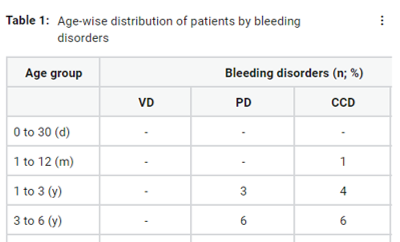Abstract
Bleeding disorders (BDs) are quite uncommon, and most bleeding episodes commonly encounter in children as a result of local factors. However, the available literature is not enough to demonstrate the commonly encountered BDs among children. Hence, this study was intended to demonstrate the hematological pattern of BD’s over different age groups of children. In this prospective study, 100 patients of either gender, aged between 0 to 12 years attending the pediatric ward with bleeding manifestations were evaluated clinically to identify an underlying etiology by physical, familial and hematological examination. The data on demographics, family history, the onset of bleeding manifestations, laboratory findings, diagnosis with respective etiologies were collected, tabulated and interpreted. Out of 100 cases, 38% had acquired BDs, followed by platelet disorders (32%), inherited (26%) and vascular BDs (4%). Among acquired cases, disseminated intravascular coagulation (25/100) with hepatic impairment (40%) is the predominant cause. In inherited cases, von-willebrand factor deficiency (18/100) was more predominant than factor VIII deficiency (12/100). School going children (6-9 years; 32%) and infants (21%) were the most affected age groups. Anemia (69%) and growth retardation (13%) were commonly observed complications. Acquired coagulopathies contribute a major portion of bleeding disorders in children. Infants and school-going children are at greater risk to develop coagulopathies. The understanding etiological cause is essential for accurate diagnosis and management in order to prevent morbidity associated with coagulopathies in children.
Full text article
Authors

This work is licensed under a Creative Commons Attribution-NonCommercial-NoDerivatives 4.0 International License.

